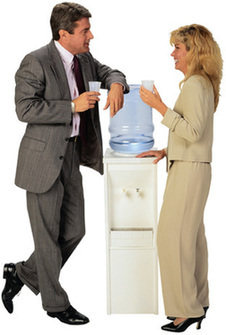在這個似乎人人都想出名的時代,普通人都可能會做一些讓人意想不到的事情來引人關注,名人們就更不用說了。于是,各類綜藝節目從來都不愁沒有“噱頭”可做。我們在辦公室的這些人呢,也就不愁閑聊的時候沒有談資了。今天,咱們就說說這個“噱頭”吧。
In a television show or radio program, a controversial or exciting segment designed to get people talking about the show is called “watercooler moment”.
在電視或廣播節目中,那些提前設計好的較具爭議性或者很精彩的節目片斷通常會成為人們的談資(即我們平時常說的節目的“噱頭”),這些片斷就叫watercooler moment。

It's a classic workplace scene: Two or three co-workers arrive at the office watercooler more or less simultaneously and a brief — and ideally non-work-related — conversation ensues. Nowadays, these confabs are just as likely to break out in the coffee room, alongside the photocopier, or while waiting to use the fax machine. But the "watercooler" was long ago chosen as the symbolic location for spontaneous workplace chinwagging.
這個短語為我們展現的是辦公室常見的一個情景:三兩個同事前后來到茶水間,然后一些簡短的寒暄就開場了,寒暄內容通常與工作無關。現在,這樣的寒暄或閑聊可能會發生在咖啡間、復印機旁,或者等候使用傳真機的間隙。但是watercooler(茶水間、飲水機)在很久以前就被選為辦公室閑聊的標志性場所了。
That's the idea underlying this phrase. Insert some controversial or titillating content into a show, and the next day the watercooler conversations will begin with the phrase "Did you see/hear last night's episode of X?"
這也就是這個短語出現的緣由。如果在節目中加入一些具有爭議性或者比較刺激的內容,那么第二天茶水間寒暄的開場白可能就會是:“你看了/聽說昨晚那…事兒了嗎?”
相關閱讀
(中國日報網英語點津 Helen )
